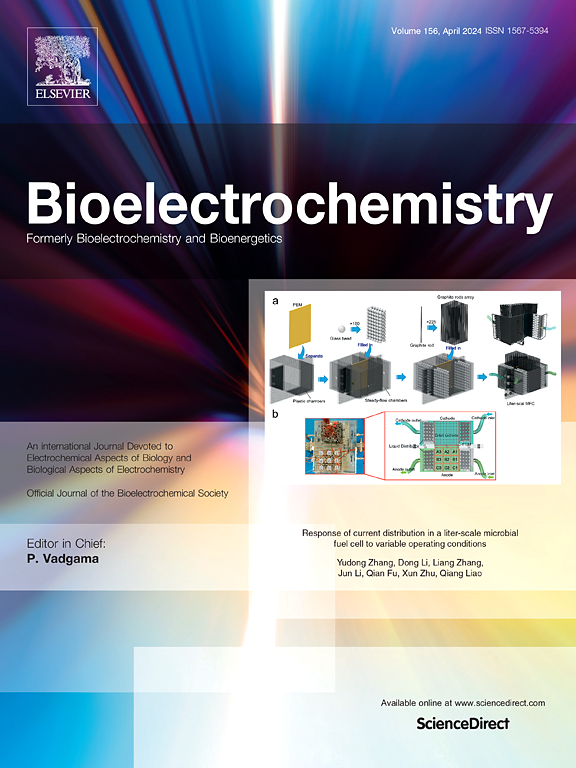Temperature-driven changes in biofilm formation and electrochemical performance of deep-sea inoculum in microbial fuel cells
IF 4.5
2区 化学
Q1 BIOCHEMISTRY & MOLECULAR BIOLOGY
引用次数: 0
Abstract
Microbial fuel cells (MFCs) generate electricity by converting organic materials and utilizing electroactive bacteria, where anodic biofilms play a vital role in electron transfer and controlling internal resistance. The adaptation of deep-sea microbial communities to diverse environmental conditions, particularly the effects of temperature on biofilm formation and MFC efficiency in high-salinity environments, remains under-explored. This study aims to fill this gap by examining how different temperatures (4 °C (F35), 25 °C (R35), and 37 °C (I35)) affect anodic biofilm formation and MFC performance. The research employs deep-sea sediment inoculum from the South China Sea to enhance understanding of microbial adaptability and optimize performance in extreme conditions. Among the tested conditions, I35 demonstrated the highest current and power densities at 172.49 mA/m2 and 20.09 mW/m2, representing increases of approximately 129 % and 350 % compared to F35. R35 displayed moderate output. Microbial analysis revealed that I35 had the highest CFU count at 7.67 × 107 CFU/mL, with Gram staining and colony morphology indicating greater diversity and a higher abundance of electroactive Gram-negative populations at elevated temperatures. Performance improved with increased temperature; however, the power gains were more significant than variations in microbial counts, underscoring the importance of microbial composition, biofilm conductivity, and electron transfer efficiency. Despite having viable bacteria, F35 showed low output due to a less electroactive community and considerable charge transfer resistance. These findings highlight the need to enhance microbial quality, not just quantity, to improve MFC performance in extreme conditions and support the future application of thermally adapted biofilms in high-salinity MFC systems.

深海微生物燃料电池中接种物生物膜形成和电化学性能的温度驱动变化
微生物燃料电池(MFCs)通过转化有机材料和利用电活性细菌来发电,其中阳极生物膜在电子传递和控制内阻方面起着至关重要的作用。深海微生物群落对不同环境条件的适应,特别是温度对高盐度环境下生物膜形成和MFC效率的影响,仍未得到充分研究。本研究旨在通过研究不同温度(4°C (F35), 25°C (R35)和37°C (I35))如何影响阳极生物膜形成和MFC性能来填补这一空白。本研究采用来自南海的深海沉积物接种物,以增强对微生物适应性的认识,并优化其在极端条件下的性能。在测试条件中,I35表现出最高的电流和功率密度,分别为172.49 mA/m2和20.09 mW/m2,与F35相比分别增加了约129%和350%。R35显示中等输出。微生物学分析显示,I35的CFU数量最高,为7.67 × 107 CFU/mL,革兰氏染色和菌落形态表明在高温下具有更高的多样性和更高的电活性革兰氏阴性种群丰度。温度越高,性能越好;然而,功率增益比微生物数量的变化更为显著,强调了微生物组成、生物膜电导率和电子传递效率的重要性。尽管有活菌,但由于电活性较低的群落和相当大的电荷转移阻力,F35显示出较低的输出。这些发现强调了提高微生物质量的必要性,而不仅仅是数量,以提高MFC在极端条件下的性能,并支持热适应生物膜在高盐度MFC系统中的未来应用。
本文章由计算机程序翻译,如有差异,请以英文原文为准。
求助全文
约1分钟内获得全文
求助全文
来源期刊

Bioelectrochemistry
生物-电化学
CiteScore
9.10
自引率
6.00%
发文量
238
审稿时长
38 days
期刊介绍:
An International Journal Devoted to Electrochemical Aspects of Biology and Biological Aspects of Electrochemistry
Bioelectrochemistry is an international journal devoted to electrochemical principles in biology and biological aspects of electrochemistry. It publishes experimental and theoretical papers dealing with the electrochemical aspects of:
• Electrified interfaces (electric double layers, adsorption, electron transfer, protein electrochemistry, basic principles of biosensors, biosensor interfaces and bio-nanosensor design and construction.
• Electric and magnetic field effects (field-dependent processes, field interactions with molecules, intramolecular field effects, sensory systems for electric and magnetic fields, molecular and cellular mechanisms)
• Bioenergetics and signal transduction (energy conversion, photosynthetic and visual membranes)
• Biomembranes and model membranes (thermodynamics and mechanics, membrane transport, electroporation, fusion and insertion)
• Electrochemical applications in medicine and biotechnology (drug delivery and gene transfer to cells and tissues, iontophoresis, skin electroporation, injury and repair).
• Organization and use of arrays in-vitro and in-vivo, including as part of feedback control.
• Electrochemical interrogation of biofilms as generated by microorganisms and tissue reaction associated with medical implants.
 求助内容:
求助内容: 应助结果提醒方式:
应助结果提醒方式:


